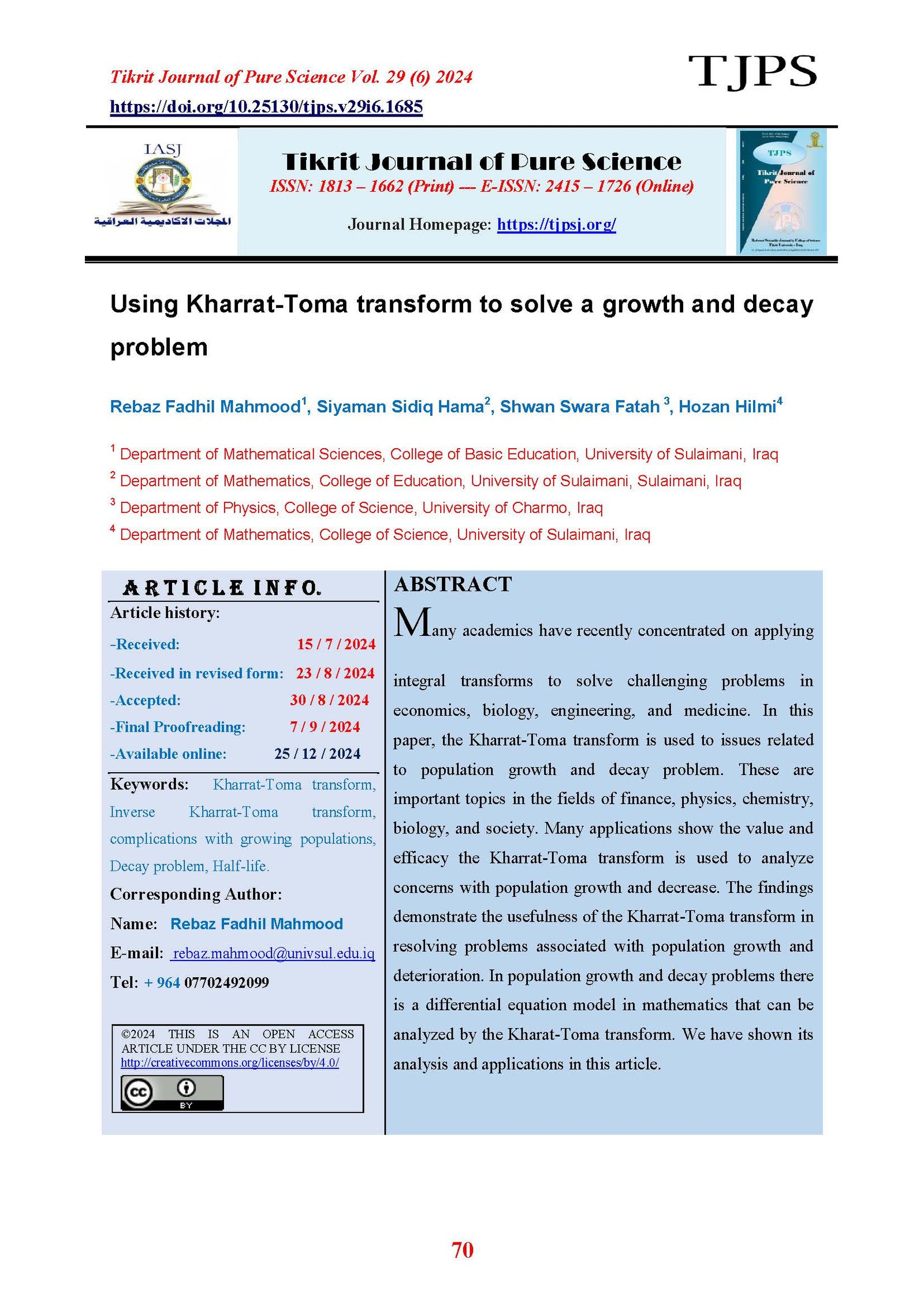Using Kharrat-Toma transform to solve a growth and decay problem
Main Article Content
Abstract
Many academics have recently concentrated on applying integral transforms to solve challenging problems in economics, biology, engineering, and medicine. In this paper, the Kharrat-Toma transform is used to issues related to population growth and decay problem. These are important topics in the fields of finance, physics, chemistry, biology, and society. Many applications show the value and efficacy the Kharrat-Toma transform is used to analyze concerns with population growth and decrease. The findings demonstrate the usefulness of the Kharrat-Toma transform in resolving problems associated with population growth and deterioration. In population growth and decay problems there is a differential equation model in mathematics that can be analyzed by the Kharat-Toma transform. We have shown its analysis and applications in this article.
Article Details

This work is licensed under a Creative Commons Attribution 4.0 International License.
Tikrit Journal of Pure Science is licensed under the Creative Commons Attribution 4.0 International License, which allows users to copy, create extracts, abstracts, and new works from the article, alter and revise the article, and make commercial use of the article (including reuse and/or resale of the article by commercial entities), provided the user gives appropriate credit (with a link to the formal publication through the relevant DOI), provides a link to the license, indicates if changes were made, and the licensor is not represented as endorsing the use made of the work. The authors hold the copyright for their published work on the Tikrit J. Pure Sci. website, while Tikrit J. Pure Sci. is responsible for appreciate citation of their work, which is released under CC-BY-4.0, enabling the unrestricted use, distribution, and reproduction of an article in any medium, provided that the original work is properly cited.
References
[1] S. A. Ahmad, S. K. Rafiq, H. D. M. Hilmi, and H. U. Ahmed, "Mathematical modeling techniques to predict the compressive strength of pervious concrete modified with waste glass powders," Asian Journal of Civil Engineering, vol. 25, no. 1, pp. 773-785, 2024. https://doi.org/10.1007/s42107-023-00753-8
[2] S. R. Kushare, D. Patil, and A. M. Takate, "The new integral transform,“Kushare transform”," International Journal of Advances in Engineering and Management, vol. 3, no. 9, pp. 1589-1592, 2021. https://doi.org/10.35629/5252-030915891592
[3] D. Patil, Y. Suryawanshi, and M. Nehete, "Application of Soham transform for solving Volterra integral equations of first kind," 2022. https://ssrn.com/abstract=4128993
[4] D. Patil, P. Shinde, and G. Tile, "Volterra integral equations of first kind by using
Tikrit Journal of Pure Science Vol. 29 (6) 2024
https://doi.org/10.25130/tjps.v29i6.1685
78
Anuj transform," International Journal of Advances in Engineering and Management, vol. 4, no. 5, pp. 917-920, 2022.
https://doi.org/10.35629/5252-0405917920
[5] D. P. Patil, P. D. Thakare, and P. R. Patil, "General Integral Transform for the Solution of Models in Health Sciences," International Journal of Innovative Science and Research Technology, vol. 7, no. 12, pp. 1177-1183, 2022.
[6] D. Patil, S. Vispute, and G. Jadhav, "Applications of Emad-Sara transform for general solution of telegraph equation," International Advanced Research Journal in Science, Engineering and Technology, vol. 9, no. 6, 2022. https://ssrn.com/abstract=4140245
[7] D. P. Patil,. P, Application of Raj Transform for Solving Mathematical Models Occurring in the Health Science and Biotechnology (December 15, 2023). Available at SSRN: https://ssrn.com/abstract=4679741 or http://dx.doi.org/10.2139/ssrn.4679741
[8] D. P. Patil, D. S. Patil, and S. M. Kanchan, "New integral transform,“Double Kushare transform”," IRE Journals, vol. 6, no. 1, pp. 45-52, 2022.
[9] D. P. Patil, P. R. Pardeshi, R. A. Shaikh, and H. M. Deshmukh, "Applications of Emad Sara transform in handling population growth and decay problems," International Journal of Creative Research Thoughts, vol. 10, no. 7, pp. a137-a141, 2022.
[10] D. Patil, B. Patel, and P. Khelukar, "Applications of Alenzi transform for handling exponential growth and decay problems," International Journal of Research in Engineering and Science, vol. 10, no. 7, pp. 158-162, 2022.
[11] D. Patil and N. Raundal, "Applications of double general integral transform for solving boundary value problems in partial differential equations," International Advanced Research Journal in Science, Engineering and Technology, vol. 9, no. 6, pp. 735-739, 2022. https://doi.org/10.17148/IARJSET.2022.96118
[12] A. Turab, H. Hilmi, J. L. Guirao, S. Jalil, N. Chorfi, and P. O. Mohammed, "The Rishi Transform method for solving multi-high order fractional differential equations with constant coefficients," AIMS Mathematics, vol. 9, no. 2, pp. 3798-3809, 2024. https://doi.org/10.3934/math.2024187
13] R. Kumar, J. Chandel, and S. Aggarwal, "A new integral transform “Rishi Transform” with application," Journal of Scientific Research, vol. 14, no. 2, pp. 521-532, 2022. https://doi.org/10.3329/jsr.v2i3.4899
[14] H. Hilmi and K. H. . Jwamer, “Existence and Uniqueness Solution of Fractional Order Regge Problem,” J. Univ. BABYLON Pure Appl. Sci., vol. 30, no. 2, pp. 80–96, Jun. 2022, . https://doi.org/10.29196/jubpas.v30i2.4186
[15] I. Podlubny, Fractional Differential Equations. San Diego: Elsevier, 1999. https://doi.org/10.1007/978-3-030-00895-6_4
[16] K. H. Faraj Jwamer and H. Hilmi, “Asymptotic behavior of Eigenvalues and
Eigenfunctions of T.Regge Fractional Problem,” J. Al-Qadisiyah Comput. Sci. Math., vol. 14, no. 3, pp. 89–100, Sep. 2022, https://doi.org/10.29304/jqcm.2022.14.3.1031
[17] H. Hilmi, R. F. Mahmood, and S. Sidiq Hama, “Existence and uniqueness of Solution for Boundary Value Problem of Fractional Order,” Tikrit J. Pure Sci., vol. 29, no. 2, pp. 79–85, Apr. 2024, https://doi.org/10.25130/tjps.v29i2.1562
[18] A. Carpinter and F. Mainardi, Fractals and Fractional Calculus in Continuum Mechanics. Springer-Verlag Wien GmbH, 1997. https://doi.org/10.1007/978-3-7091-2664-6
[19] B. N. Kharrat and G. A. Toma, “A new integral transform: Kharrat - Toma transform and its properties,” World Appl. Sci., vol. 38, no. 5, pp. 436–443, 2020, https://doi.org/10.3390/SYM12060925
[20] S. K. Lydia, M. M. Jancirani, and A.Alphonse Anitha, “Numerical solution of nonlinear fractional differential equations using Kharrat-Toma iterative method,” NVEO, vol. 8, no. 4, pp. 9878–9890, 2021, https://doi.org/10.1142/S0218348X21501528
[21] D. G. Zill, “A First Course in Differential Equations with Modeling Applications,” p. 426, 2009.
[22] S. Aggarwal and G. P. Singh, “Sawi Transform for Population Growth and Decay Problems,” Int. J. Latest Technol. Eng. Manag. Appl. Sci., vol. VIII, no. VIII, pp. 157–162, 2019.
